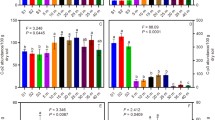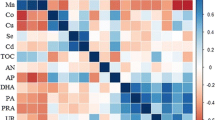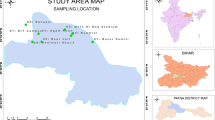Abstract
Internationally there is a gradual decline in availability of fresh water to be used for irrigation. As a consequence, the use of drain water for irrigating agricultural lands is on the rise particularly in urban areas of develo** countries especially Egypt. On the other hand, there is increasing concern regarding the exceedance of statutory and advisory food standards for trace metals throughout the world. A study was undertaken to assess the long-term effect of irrigation with drain water on heavy metal content in soils and diversity of terricolous biota. An agroecosystem in Bahr El-Baqar area, south of Port Said, Egypt were selected where various cereals, vegetable and fodder crops have successfully been grown. During the period from September (2004) to February (2005), 25 soil profiles, 100 soil and 30 water samples were collected from cultivated soil and drain of Bahr El-Baqar. Soil heavy metals content (Zn, Pb, Cd, Co, Mn and Cu), gypsum, organic matter, total calcium carbonates, cations, anions, electric conductivity and pH were determined. Water samples has been subjected to various analyses including water temperature, pH, total soluble salts, electric conductivity, total nitrogen, total phosphate, heavy metals and organic loads (chemical oxygen demand and biological oxygen demand). For isolation and examination of total mycobiota, arbuscular-mycorrhizal fungi (AMF) and nematodes from rhizosphere soils, samples were collected from dominant plant species in the study area. Obtained data were subjected to multivariate analysis by using Canonical Correspondence Analysis to find out the relationship between biota and environmental variables. Results indicated that concentrations of heavy metals exceeded the maximum allowable limits while water analyses showed that organic load values are slightly increase in all examined samples and samples were not complying with the standard value given by law 48/1982 for ambient water quality in the drain. It was possible to encounter as many as 43 fungal species belonged to twenty-one genera from five sites in the agroecosystem in south Port Said. The results show that Zygomycota represented by six species (7.59% of the total isolate number), teleomorphic Ascomycota (3 species, 3.78%), anamorphic Ascomycota (31 species, 86.96%) and mitosporic fungi (3 species, 1.67%). The AM fungal spores obtained belonged to the three genera namely Acaulospora, Gigaspora, and Glomus and eight species. While family Glomeraceae accommodates the greatest range of species (6 species), the other family Gigasporaceae accommodate the lowest range (two species). Twelve species belonging to eight genera and six families of plant-parasitic nematodes were identified throughout the study. Total levels of heavy metals showed a trend relationship between metal concentration in soil and long term of irrigation assuming that there is a continuous deposition of heavy metals on the soils due the continuous use of Bahr El-Baqar drain in watering soil for many years in which both living and non-living components of ecosystem are hazardly affected. Detailed studies to minimize the quantity and improve the quality of wastewater discharged should be carried out for each industry. Research must take the objective of sustainability into consideration. Legislation sensible to environmental control should depend on a thorough knowledge of the existing situation and careful assessment of its likely impact on the development. On the other hand activation of law 4/1994, for the protection of environment in Egypt, is urgently needed.





Similar content being viewed by others
References
Abdel-Azeem, A. M. (2003). Ecological and taxonomical studies on ascospore-producing fungi in Egypt. PhD thesis, Faculty of Science, Suez Canal University.
Abdel-Shafy, H. I., & Aly, R. O. (2002). Water issue in Egypt: Resources, pollution and protection endeavors. CEJOEM, 8(1), 3–21.
Aboulrous, S. A., Holah, S., & Badawy, S. H. (1989). Influence of prolonged use of sewage effluent in irrigation on heavy metal accumulation in soils and plants. Zeitschrift für Pflanzenernährung und Bodenkunde, 152, 51–55.
Ali, O. M., El-Sikhry, E. M., & El-Farghal, W. M. (1993). Effect of prolonged use of Bahr El Baqar drain water for irrigation on the total heavy metals content of South Port Said soils. In: Proc. 1st Conf. Egypt. Hung. Env. Egypt, pp. 53–57.
Al-Shayeb, S. M., Al-Rajhi, M. A., & Seaward, M. R. D. (1995). The date palm (Phoenix dactylifera L.) as a biomonitor of lead and other elements in arid environments. Science of the Total Environment, 168, 1–10.
Anonymous. (1994). Global environmental facility. Report on Egyptian engineered wetlands. Washington, DC: UNDP/IJNEP, World Bank.
APHA (1995). Standard methods for the examination of water and wastewater (20th ed.). Washington, DC: American Public Health.
Attia, Y. D. (1994). Rainfed agriculture in the northern coast of the Sinai. Workshop of Sustainable Development of the Rainfed Areas in Egypt. Cairo, Egypt: Academy of Scientific Research and Technology.
Ayyad, M. A., Abdel-Razik, M., & Mehannas, S. (1983). Climatic and vegetational gradients in the Mediterranean desert of Egypt. In: Pre-report of the Mediterranean Bioclimate Symposium, (pp. 1–14), Montpellier, France, 18–21 May.
Barbour, M. G., Burk, J. H., & Pitts, W. D. (1987). Terrestrial plant ecology (2nd ed., 634 pp). Menlo Park, CA: Benjamin Cummings.
Biernacki, M., Lovett-Doust, J., & Lovett-Doust, L. (1996). Vallisneria americana as a biomonitor of aquatic ecosystems: Leaf-to-root surface area ratios and organic contamination in the Huron-Erie Corridor. Journal of Great Lakes Research, 22, 289–303.
Biernacki, M., Lovett-Doust, J., & Lovett-Doust, L. (1997). Temporal biomonitoring using wild celery, Vallisneria americana. Journal of Great Lakes Research, 23, 97–107.
Booth, C. (1971). Fusarium, laboratory guide to the identification of the major species. Kew, Surrey, England: Commonwealth Mycological Institute.
Brundrett, M., Bougher, N., Dell, B., Grove, T., & Malajczuk, N. (1996). Working with Mycorrhizae in forestry and agriculture (p. 374). Canberra: Australian Center for International Agricultural Research.
Carson, B. L., Ellis, H. V., & McCann, J. L. (1986). Toxicology and biological monitoring of metals in humans (vol. 71, p. 133). Chelsea, MI: Lewis.
Chaphekar, S. B. (1991). An overview on bioindicators. Journal of Environmental Biology, 12, 163–168.
Christie, J. R., & Perry, V. G. (1951). Removing nematodes from the soil. Proceedings of the Helminthological Society of Washington, 8, 106–108.
Cortet, J., Gomot-De-Vauflery, A., Gomot, L., Poinsot-Balaguer, N., Texier, C., & Cluzeau, D. (1999). The use of invertebrate soil fauna in monitoring pollutant effects. European Journal of Soil Biology, 35, 115–134.
Del Val, C., Barea, J. M., & Azcón-Aguilar, C. (1999). Diversity of arbuscular mycorrhizal fungus populations in heavy-metal-contaminated soils. Applied and Environmental Microbiology, 65(2), 718–723.
Domsch, K. H., Gams, W., & Traute-Heidi, A. (1980). Compendium of soil fungi (vol. I & II). New York: Academic.
Egyptian Environmental Affairs Agency (EEAA). (1994). Executive Regulations of the Environmental Promulgation Law (Law 4/1994), 200 pp. Cairo, Egypt: The Egyptian Environmental Affairs Agency, Cabinet of Ministers.
Egyptian Environmental Affairs Agency (EEAA). (1996). Technical report No. 2.
Eid, M. A. (1984). Studies on some heavy metals in soils and water. MSc thesis, Ain Shams University, Egypt.
Ellis, M. B. (1971). Dematiaceoua hyphomycetes (p. 608). Kew, Surrey, England: Commonwealth Mycological Institute.
Ellis, M. B. (1976). More dematiaceoua hyphomycetes (p. 507). Kew, Surrey, England: Commonwealth Mycological Institute.
El-Morsy, E. M. (2004). Cunninghamella echinulata a new biosorbent of metal ions from polluted water in Egypt. Mycologia, 96(6), 1183–1189.
Ezzat, A. I. (1989). Studies on phytoplankton in some polluted areas of Lake Manzala. Bulletin of the National Institute of Oceanography and Fisheries, ARE, 15(1), 1–19.
Gerdemann, J. W., & Nicolson, T. H. (1963). Spores of mycorrhizal Endogone species extracted from soil by wet sieving and decanting. Transactions of the British Mycological Society, 46, 235–244.
Gildon, A., & Tinker, P. B. (1983). Interactions of vesicular-arbuscular infection and heavy metals in plants. I. The effect of heavy metals on the development of vesicular-arbuscular mycorrhizas. New Phytologist, 95, 247–261.
Goodey, T. (1963). Soil and freshwater nematodes (544 pp). New York: Wiley.
Hafez, N., Abdel-Razek, S. A., & Hafez, M. B. (1999). Accumulation of some heavy metals on Aspergillus flavus. Journal of Chemical Technology & Biotechnology, 68(1), 19–22.
Hiroki, M. (1992). Effects of heavy metal contamination on soil microbial population. Soil Science and Plant Nutrition, 38, 141–147.
Jackson, M. L. (1967). Soil chemical analysis. Englewood Cliffs, NJ: Prentice Hall.
Johnson, L., Curl, E., Bond, J., & Fribourg, H. (1960). Methods for studying soil microflora-plant disease relationships. Minneapolis: Burgess.
Jordan, M. J., & LeChevalier, M. P. (1975). Effects of zinc-smelter emissions on forest soil microflora. Canadian Journal of Microbiology, 21, 1855–1865.
Kamel, A. K. (2001). Vegetation structure in Lake Manzala, Egypt (p. 176). MSc thesis, Faculty of Science, Suez Canal University, Ismailia.
Kapoor, A., Viraraghavan, T., & Cullimore, D. R. (1999). Removal of heavy metals using the fungus Aspergillus niger. Bioresource Technology, 70(1), 95–104(10).
Kelly, J. J., Häggblom, M. M., & Tate, R. L. (2003). Effects of heavy metal contamination and remediation on soil microbial communities in the vicinity of a zinc smelter as indicated by analysis of microbial community phospholipid fatty acid profiles. Biology and Fertility of Soils, 38, 65–71.
Khalil, M. T. (1985). The effect of sewage and pollutional wastes upon Bahr El-Baqar Drain and the southern area of Lake Manzala, Egypt. Egyptian Journal of Wildlife and Natural Resources, 6, 162–171.
Kikovic, D. D. (1997). Influence of heavy metals emitted by thermoelectrical power plants and chemical industry on Kosovo soils microflora. Review of Research Work at the Faculty of Agriculture (Belgrade), 42, 61–75.
Kirk, P. M., Cannon, P. F., David, J. C., & Stalpers, J. A. (Eds.) (2001). Ainsworth & Bisby’s dictionary of the fungi (9th ed.). Wallingford, UK: CABI.
Kloke, A. (1980). Richwerte ‘80, Orientierungsdaten für tolerierbare Gesamtgehalte einiger Elemente in Kulturböden, Mitt. VDLUFA, Nr.2, 9–11.
Koomen, I., McGrath, S. P., & Giller, K. E. (1990). Mycorrhizal infection of clover is delayed in soils contaminated with heavy metals from past sewage sludge applications. Soil Biology & Biochemistry, 22, 871–873.
Korhola, A., Weckstrom, J., & Nyman, M. (1999). Predicting the long-term acidification trends in small subarctic lakes using diatoms. Journal of Applied Ecology, 36, 1021–1034.
Lambou, V. W., & Williams, L. R. (1980). Biological monitoring of hazardous wastes in aquatic systems. In: Second interagency workshop on in situ water sensing: Biological sensors (pp. 11–18). Pensacola Beach, Florida.
Lande, R. (1996). Statistics and partitioning of species diversity, and similarity among multiple communities. Oikos, 76, 5–13.
Løkke, H., & Van Gestel, C. A. M. (Eds.) (1998). Handbook of soil invertebrate toxicity tests: New test systems for assessing sublethal effects of chemicals on fauna in the soil ecosystem (281 pp). Chichester: Wiley.
Lovett-Doust, J., Schmidt, M., & Lovett-Doust, L. (1994). Biological assessment of aquatic pollution: A review with emphasis on plants as biomonitors. Biological Reviews, 69, 147–186.
Madden, K. E., & Fox, B. J. (1997). Arthropods as indicators of the effects of fluoride pollution on the succession following sand mining. Journal of Applied Ecology, 34, 1239–1256.
Markert, B. (1993). Plants as biomonitors/indicators for heavy metals in the terrestrial environment. Weinheim: VCH.
Miersch, J., Tschimedbalshir, M., Bärlocher, F., Grams, Y., Pierau, B., Schierhorn, A., et al. (2001). Heavy metals and thiol compounds in Mucor racemosus and Articulospora tetracladia. Mycological Research, 105, 883–889.
Moriarty, F. (1990). Ecotoxicology: The study of pollution in ecosystems (2nd ed.). New York: Academic.
Morton, J. B., & Benny, G. L. (1990). Revised classification of arbuscular mycorrhizal fungi (Zygomycetes): A new order Glomales, two new suborders, Glominae and Gigasporinae, and two new families, Acaulosporaceae and Gigasporaceae, with an emendation of Glomaceae. Mycotaxon, 37, 471–491.
Neher, D. A. (2001). Role of nematodes in soil health and their use as indicators. Journal of Nematology, 33(4), 161–168.
Nile Basin National Water Quality Monitoring Baseline Study Report for Egypt (2005) p. 127.
Page, A. L., Miller, R. H., & Keeny, D. R. (1982). Methods of soil analysis. Part 2. Chemical and microbiological properties. Am. Soc. of Agron. in Madison, Wisconsin, USA.
Peèiulytë, D. (2001). Research of the influence of zinc on soil mycoflora with special attention to Zn-resistant fungi. Biologija Nr., 4, 19–21.
Pennanen, T., Frosetgård, A., Fritze, H., & Btååh, E. (1996). Phospholipid fatty acid composition and heavy metal tolerance of soil microbial communities along two heavy metal polluted gradients in coniferous forests. Applied and Environmental Microbiology, 62, 420–428.
Phillips, J. M., & Hayman, D. S. (1970). Improved procedures for clearing roots and staining parasitic and vesicular-arbuscular mycorrhizal fungi for rapid assessment of infection. Transactions of the British Mycological Society, 55, 158–161.
Piper, C. S. (1950). Soil and plant analysis. A monograph from the wait. Agric. Res. Inst., Adeliade Univ., S. A., Australia.
Pitt, J. I. (1979). The genus Penicillium and its teleomorphic states Eupenicillium and Talaromyces. London: Academic.
Ramadan, A. A. (2003). Heavy metal pollution and biomonitoring plants in Lake Manzala, Egypt. Pakistan Journal of Biological Sciences, 6(13), 1108–1117.
Raper, K. B., & Fennell, D. I. (1965). The genus Aspergillus. Baltimore: Williams & Wilkins.
Raper, K. B., & Thom, C. (1949). A manual of the penicillia. Baltimore: Williams & Wilkins.
Rashed, I. G., & Holmes, P. G. (1984). Chemical survey of Bahr El Bakar Drain system and its effects on Manzala Lake. In: Proceedings of the 2nd Egyptian Congress of Chemical Engineering, (pp. 1–10), Cairo, Egypt, March 18–20, 1984.
Rattan, R. K., Datta, S. P., Chhonkar, P. K., Suribabu, K., & Singh, A. K. (2005). Long-term impact of irrigation with sewage effluents on heavy metal content in soils, crops and groundwater – a case study. Agriculture, Ecosystems and Environment, 109, 310–322.
Richards, L. A. (1954). Diagnosis and improvement of saline and alkali soils. US Department of Agriculture Handbook No. 60. US Govt. Print Off, Washington, D. C.
Ruttner, F. (1963). Fundamentals of limnology (3rd ed., 307 pp). Toronto: Univ. of Toronto Press.
Samoiloff, M. R., Bell, J., Birkholz, D. A., Wester, G. R. B., Arnott, E. G., Pulak, R., et al. (1983). Combined bioassay chemical fractionation scheme for the determination and ranking of toxic chemicals in sediments. Environmental Science and Technology, 17, 329–334.
Smith, B. M. (1991). An inter- and intra-agency survey of the use of plants for toxicity assessment. In: J. W. Gorsuch, W. R. Lower, W. Wang, & M. A. Lewis (Eds.), Plants for toxicity assessment: Second volume, ASTM SIP 1115 (pp. 41–59). Philadelphia: American Society of Testing and Materials.
Soil Survey Staff. (1975). Soil taxonomy, a basic system for soil classification for making and interpreting of soil surveys. Agriculture handbook no. 436. Washington, D. C.: USDA Soil Conservation Service, 20402.
Soil Survey Staff. (1998). Keys to soil taxonomy (8th ed., 326 pp). Washington D. C.: USDA Natural Resource Conservation Service.
Soil Survey Staff. (2003). Keys to soil taxonomy (9th ed., 327 pp). USDA.
Soliman, F. A., & Ramadan, A. A. (1993). Mineral pollution and plant indicators in some localities, South Sinai, Egypt (pp. 79–87). Proceedings 1st Conf. Egypt. Hung. Env. Egypt, 1993.
Spurgeon, D. J., & Hopkin, S. P. (1999). Seasonal variation in the abundance, biomass and biodiversity of earthworms in soils contaminated with metal emissions from a primary smelting works. Journal of Applied Ecology, 36, 173–183.
ter Braak, C. J. F. (1986). Canonical correspondence analysis: A new eigenvector technique for multivariate direct gradient analysis. Ecology, 67, 1167–1179.
ter Braak, C. J. F. (1988). CANOCO – A FORTRAN program for canonical community ordination by (partial) (detrended) (canonical) correspondence analysis, principal components analysis and redundancy analysis (version 2.1), Technical report LWA-88-02 (95 pp). Wageningen: Agricultural Mathematics Group.
Trappe, J. M., & Molina, R. (1986). Taxonomy and genetics of mycorrhizal fungi: Their interactions and relevance. In: V. Gianinazzi-Pearson & S. Gianinazzi (Eds.), Mycorrhizae: Physiology and genetics (pp. 133–146). Paris: INRA.
U. S. Environmental Protection Agency. (1986). Test methods for evaluating solid waste: physical/chemical methods. SW-846. Washington, D. C.: USEPA, Office of Solid Waste and Emergency Response.
Valla, M., Kozák, J., Němeček, J., Matula, S., Borůvka, L., & Drábek, O. (2000). Pedologické praktikum. [Skriptum.] ČZU, Praha.
Van Gestel, C. A. M., & Van Straalen, N. M. (1994). Ecotoxicological test systems for terrestrial invertebrates. In: M. Donker, H. Eijsackers, & F. Heimbach (Eds.), Ecotoxicology of soil organisms (pp. 205–228). Boca Raton, FL, USA: Lewis, CRC.
Van Straalen, N. M., & Van Gestel, C. A. M. (1993). Soil invertebrates and microorganisms. In: P. Calow (Ed.), Handbook of ecotoxicology (vol. 1, pp. 251–277). Oxford, England: Blackwell.
von Arx, J. A. (1981). Genera of fungi sporulating in pure culture (3rd ed.). Vaduz: J. Cramer
von Arx, J. A., Guarro, J., & Figueras, M. J. (1986). The ascomycete genus Chaetomium. Beihefte zur Nova Hedwigia, 84, 1–162.
Walker, C. (1992). Systematics and taxonomy of the arbuscular mycorrhizal fungi. Agronomie, 12, 887–897.
Water Master Plan Project (WMP). (1981). Water and wastewater studies: Municipal and industrial sectors. Tech. Rep. No. 9, UNDP-EGY 173/024, Cairo, Egypt.
Weiss, B., & Larink, O. (1991). Influence of sewage sludge and heavy metals on nematodes in an arable soil. Biology and Fertility of Soils, 12(1), 5–9.
Westerman, R. L. (Ed.) (1990). Testing soils for salinity and sodicity. Soil testing & plant analysis (3rd ed.). Ch. 12, 299–336. SSSA Book Series, No. 3.NA.
World Health Organization (W. H. O.). (1993). Guidelines for drinking water quality (2nd ed., vol. 1). Recommendations. Geneva: World Health Organization.
Wright, G. H. (1939). Soil analysis. London: Marby.
Zaguralskaya, L. M. (1997). Microbiological monitoring of forest ecosystems in the northern taiga subzone in conditions of anthropogenic impact. Lesovedenie, 5, 3–12.
Zaki, M. M. M. (1994). Microbiological and toxicological study of the environmental pollution of Lake Manzala (108 pp). MSc Thesis, Faculty of Science, Suez Canal University, Ismailia, Egypt.
Author information
Authors and Affiliations
Corresponding author
Rights and permissions
About this article
Cite this article
Abdel-Azeem, A.M., Abdel-Moneim, T.S., Ibrahim, M.E. et al. Effects of Long-Term Heavy Metal Contamination on Diversity of Terricolous Fungi and Nematodes in Egypt - A Case Study. Water Air Soil Pollut 186, 233–254 (2007). https://doi.org/10.1007/s11270-007-9480-3
Received:
Accepted:
Published:
Issue Date:
DOI: https://doi.org/10.1007/s11270-007-9480-3




